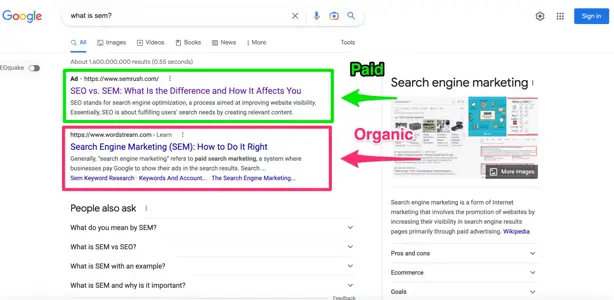SEO & SEM: What are their roles and functions in marketing?
For overseas students majoring in marketing, especially those in digital marketing, SEO and SEM are not unfamiliar concepts. However, because SEO and SEM require practical solid experience and skills, overseas students still need to prepare well for job applications and understand the industry differences between China and abroad.
In this industry knowledge article, we will introduce the roles of SEO and SEM positions in marketing roles within companies, as well as their specific job functions and requirements.
Importance of Websites

Websites are essential for many companies, serving not only as the online face of the company but also as an indispensable channel for acquiring new customers and generating revenue.
Due to the unique nature of website access, people cannot find the content they want to see directly when they do not know the specific web address. With the development of search engines, people are increasingly accustomed to using search engines to find the content they desire.
However, when the number of websites becomes significant, and the amount of homogeneous content increases, ensuring that users can quickly find their own websites through search or maximize exposure in search engines becomes an essential task. To address the need for users to find their desired content more quickly and accurately, positions such as SEO and SEM have emerged.
Concepts of SEO and SEM
SEO (Search Engine Optimization)
SEO refers to making internal and external adjustments and optimizations to a website based on an understanding of the natural ranking mechanisms of search engines. The goal is to improve a website's natural keyword rankings in search engines, generate more traffic, and achieve website sales and brand-building objectives.
SEM (Search Engine Marketing)
SEM involves paid advertising on search engines to increase a website's visibility and drive traffic as a network marketing activity.
Although the names of these two positions differ by just one word, they have some differences in essence. To use a gaming analogy, SEO is like becoming powerful by gradually completing tasks and accumulating experience. In contrast, SEM is a method that achieves quick results by spending money.
SEO Positions

First, it's essential to clarify why companies need SEO positions in their marketing departments.
Taking lipstick as an example, many people want to buy lipstick every day, and there are many searches for the keyword "lipstick." However, there are numerous lipstick brands on the market, each with various product lines. So, how can users searching for keywords related to lipstick see their brand and expand their influence?
Website optimization and maintenance costs can be very high. SEO is a relatively inexpensive method, especially compared to purchasing paid advertising positions. SEO is not dependent on the independence of search engines; through optimization, the website can appear at the top in various browsers, be it, Google, or other browsers.
Additionally, SEO offers stability. With proper maintenance, the website's position can remain stable for several years. Most importantly, through naturally optimized rankings via SEO, it's possible to filter out competitors and invalid clicks. This results in precise traffic, which can potentially benefit the company.
Data Collection
In terms of data collection, SEO positions require an understanding of the principles and characteristics of various search engines and familiarity with ranking rules and patterns in different environments.
After understanding the rules of search engines themselves, much of the work involves collecting various data, such as when and under what circumstances users might search for lipstick.
As an SEO specialist, you need to identify all possible keyword combinations to ensure that when someone searches for these terms, your lipstick webpage appears among the top results. For platform or e-commerce products, the scope of keyword coverage is extensive, making data collection a substantial task.
Content Optimisation
However, data collection is just the first step. Optimization is a significant part of SEO positions, which includes content optimization, keyword optimization, internal link optimization, code optimization, image optimization, and more.
A significant portion of the work is dedicated to optimization to ensure the website's front-end rankings. SEO positions use various online resources and media to increase website traffic and improve dissemination effects. They communicate with various departments, refine requirements, and complete website promotion tasks in stages, meeting quality standards and deadlines.
Regardless of the methods used, the core of SEO is optimization through data collection and various means to improve a website's natural rankings and traffic, thereby increasing the company's intangible value.
SEM Positions

For companies, taking time to achieve results is ideal. However, the rapidly changing market environment often requires companies to promote themselves quickly. SEO often requires months of effort to see results and may lead to changes in position due to the complexity of search engines.
Therefore, at times like these, SEM, similar to the concept of "pay to win" in gaming, becomes an indispensable method for companies. In simple terms, SEM is about spending money to make a company's website rank higher for specific keywords when searched.
Some of the work in SEM positions is similar to SEO, such as collecting keywords, organizing related data, and discovering more content related to the website. Additionally, SEM positions involve managing the company's SEM accounts, daily management, and ad placements.
Responsibilities include analyzing the performance of ad placements and continuously optimizing the advertising strategy to improve return on investment. They are responsible for internal communication regarding search engine marketing and external coordination and implementation of advertising.
SEM positions involve rapidly improving website rankings and increasing webpage exposure. The primary responsibility of this position is to use a reasonable budget to ensure the company's webpages are displayed as prominently as possible, maximizing exposure.
In Summary
SEO and SEM positions both aim to optimize web visibility. One focuses on gradual and detailed work, while the other relies on quick results through financial investment. Many companies have both SEO and SEM positions that complement each other to enhance website visibility.
Aniday's HR Services
Headhunting Service
Find and recruit quality candidates in just 1 week! Supported by 40,000 experienced headhunters in IT, Finance, Marketing… capable of recruiting in any region.
Headhunting Service ➔Employer of Record (EOR) Service
On behalf of your business, we recruit employees and handle payroll without the need to establish a company in markets such as Vietnam, Singapore, Malaysia, India, Indonesia…
Employer of Record (EOR) Service ➔